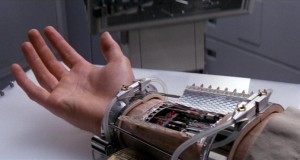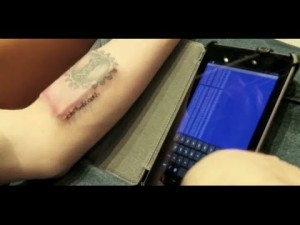Ever get tired of carrying around important thumb drives (and then forgetting where you left them)? What about headphones? Are they really comfortable to wear? And what about typing an e-Mail to your professor? Wouldn’t it be easier to just think what you want to say to her? What if you could interface with technology in a way that felt completely natural? What if that interface was as unnatural as it gets?
In my last post, I talked about genetic modification. While researching that piece, I found a ton of fascinating information on human-technology interfaces that focused on hacking the human organism (not genetics). We’re talking about technology that lets you overcome your physical limitations: Strength, intelligence, memory and health could all be augmented to advanced levels using technology that is A. currently available or 2. in development.
Wetware is a term coined by grinders (a kind of DIY biohacker that believe in dramatic human augmentation through technology) that refers to technology designed to be built directly into the human body. We’re not talking about keyboards or cell phones; this is technology designed to be hardwired into the human body, like prosthetics and implants.
 Prosthetic limbs and artificial hearts obviously serve pretty important functions. But wetware doesn’t stop there. From diagnostic tools to interpret your body’s vitals to RFID chips so only you can unlock your computer or cell phone, the human body is being hacked by a growing number of amateur cyborgs.
Prosthetic limbs and artificial hearts obviously serve pretty important functions. But wetware doesn’t stop there. From diagnostic tools to interpret your body’s vitals to RFID chips so only you can unlock your computer or cell phone, the human body is being hacked by a growing number of amateur cyborgs.
How about magnetic headphones surgically implanted into the ear? Rich Lee of Utah did it, but not just for discretely listening to awesome jams. Lee is facing blindness and is hoping to augment his body to the point that he can interpret his physical surroundings with sonar. (I have yet to see a photo of him in a Batman T-Shirt, but I know he has one).
Other grinders have gotten NFC (Near-Field Communication) devices implanted in their hands so they can always have important data (literally) at their fingertips. Magnets also feature prominently in embedded technology, allowing people to “sense” magnetic fields.
Ready for a less invasive (i.e. gross) example of transhuman technology? For years the US government has been working on developing exoskeletons that will enhance troops’ abilities in combat. These aren’t hired-wired; the service members can take them on and off at will. They’re designed to move as smoothly and naturally as the troops wearing them and to support nearly all of the weight of any gear that needs to be carried. Having lugged a 70+ pound MOLLE pack in the desert, I assure you this piece of equipment is awesome and exciting for all potential users. Naturally, the scientists building these bad boys are working on amplifying speed and effective strength, as well as making them bulletproof. (Quite worthy goals, I say). I just wonder how long we’ll have them before they are hardwired; especially with the recent boom in implanting 3D-printed body parts. (Right now the prints are pretty basic bone structures, mostly skulls–but it isn’t hard to imagine trying to add circuitry to the schematics for a mental processing upgrade).
 Stepping away from gray steel and up to gray matter, there is a lot of research going on involving the brain and how it works. In particular, neurobiologists are working on developing brain-to-computer-to-brain interfaces. The idea is to enable people to communicate without the very inhuman keyboard–which, as we all know is prone to typos, dead keys and (the most disabling of all problems) cats stretching across the length of the device at the exact moment you have something really important to write. Well, a team of international researchers have developed technology that allows telepathy. Okay, it’s actually a really complicated method of changing radiation patterns from the brain into binary and transferring them across a network to somebody wearing a special receiver, who sees light patterns in the bottom of their vision that they can read in a similar fashion to Morse Code, thus allowing a very time-consuming bout of mental yoga to spell out, “Hello.” But come on; if they were sharing memories like the pilots in Pacific Rim you would’ve heard about it already, right?
Stepping away from gray steel and up to gray matter, there is a lot of research going on involving the brain and how it works. In particular, neurobiologists are working on developing brain-to-computer-to-brain interfaces. The idea is to enable people to communicate without the very inhuman keyboard–which, as we all know is prone to typos, dead keys and (the most disabling of all problems) cats stretching across the length of the device at the exact moment you have something really important to write. Well, a team of international researchers have developed technology that allows telepathy. Okay, it’s actually a really complicated method of changing radiation patterns from the brain into binary and transferring them across a network to somebody wearing a special receiver, who sees light patterns in the bottom of their vision that they can read in a similar fashion to Morse Code, thus allowing a very time-consuming bout of mental yoga to spell out, “Hello.” But come on; if they were sharing memories like the pilots in Pacific Rim you would’ve heard about it already, right?
So what’s the likelihood of us going transhuman? Are we really locked into course for this, or is all of this just speculative science?
Every example I’ve offered you is real. Each of these items exists and is being used by a living, breathing human being right now. And according to research conducted by the National Intelligence Council, some of the most advanced augmentations–including brain-interface technology–will be available by 2030.
That paper speculates on some technology that just isn’t here yet, like neural chemicals to override the brain’s petty suggestions about sleeping or not studying quantum mechanics 24/7 and artificial irises allowing humans to see infrared and other non-visible-to-the-unaided-eye spectrums (which is a lot harder than you think, because scientists are just now developing artificial retinas that come close to mimicking natural sight for blind people).
 You might think all of this is really cool and be ready to start counting down the calendar to January 1st, 2030. Before you start marking black Xs with your Sharpie, there are some down sides to all of this. For starters, the image on the left is what an implanted circadia computer chip looks like. What does that giant subcutaneous LEGO block do, you might ask? In addition to ensuring your arm never rests comfortably on the armrest again, it collects biomedical data and transmits it to the internet via Bluetooth. And it charges wirelessly, which is kind of cool because it has LEDs in it that light up when it’s charging and make your arm look like a Christmas tree.
You might think all of this is really cool and be ready to start counting down the calendar to January 1st, 2030. Before you start marking black Xs with your Sharpie, there are some down sides to all of this. For starters, the image on the left is what an implanted circadia computer chip looks like. What does that giant subcutaneous LEGO block do, you might ask? In addition to ensuring your arm never rests comfortably on the armrest again, it collects biomedical data and transmits it to the internet via Bluetooth. And it charges wirelessly, which is kind of cool because it has LEDs in it that light up when it’s charging and make your arm look like a Christmas tree.
Even if you’re cool with the blocky, 2D-human look, let’s not forget about technological problems with all of this. For starters, implanting metal or magnets will preclude any MRI study of your body. I don’t think I’d want to feel the effect of magnetic waves ripping the “sensors” out of my fingertips. And let’s not forget that RFID and Bluetooth hacking are real threats we face right now. Imagine if someone hacked into your artificial eye and forced fed you an endless stream of Robot Chicken. Oh, the horror!
To recap, much of the transhuman technology we’ve covered is awesome. Some of it is really weird and invokes the reaction, “yes, but why?” (While the magnetic implants might make for some really cool magic tricks, I’m not sure that being able to sense true magnetic north is really that beneficial for most people). All of it is the expression of humanity’s desire to exceed our boundaries. For as long as people have existed, we’ve been extending our physical abilities through technology. Our innovations pulse through history: First an expansion upon an idea, then a contraction as we internalize it as much as possible.
Early people desired safety, so they developed and carried large shields. This protection was refined into body armor, allowing us to move more naturally in the presence of danger. We wished to capture the world around us and developed cameras and film development labs; and then pulled the technology into a pair of eyeglasses for effortless use.
Today we have archaic interfaces developed from the early human survival trait of adapting to our environment to fulfill a need. As we are enveloped by progressively self-constructed environments, we begin reshaping the artificial world and demanding that our technology complement our form, not dictate it.
As technology becomes more and more personal, we can rest assured that the way we interface with it will also become more intimate. Even so, the choice between implant and exoskeleton is an individual one–at least for now.
Sources
TALOS project. Defense Media Network. Steven Hoarn. 2/13/2014.
Cyborg America. Ben Popper. 8/8/2012.
Biohacking/Grinder Update: Tim Cannon Implants Circadia 1.0. Peter Rothman. 10/21/2013.
Hacking RFID Tags. Sean Michael Kerner. 7/31/2013.
Patient Receives 3d Printed Implant. David J. Hill. 3/28/2013.
Bionic Eye Implant Will Become Avaialable in Coming Weeks. Cameron Scott. 11/19/2013.
